Exploring the Artistry of Manicure Stencils
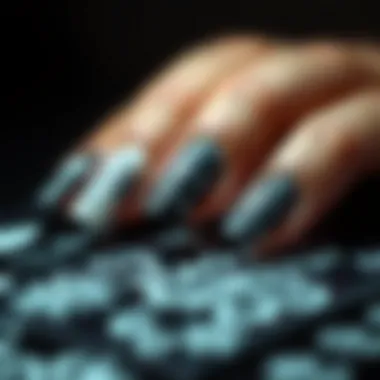
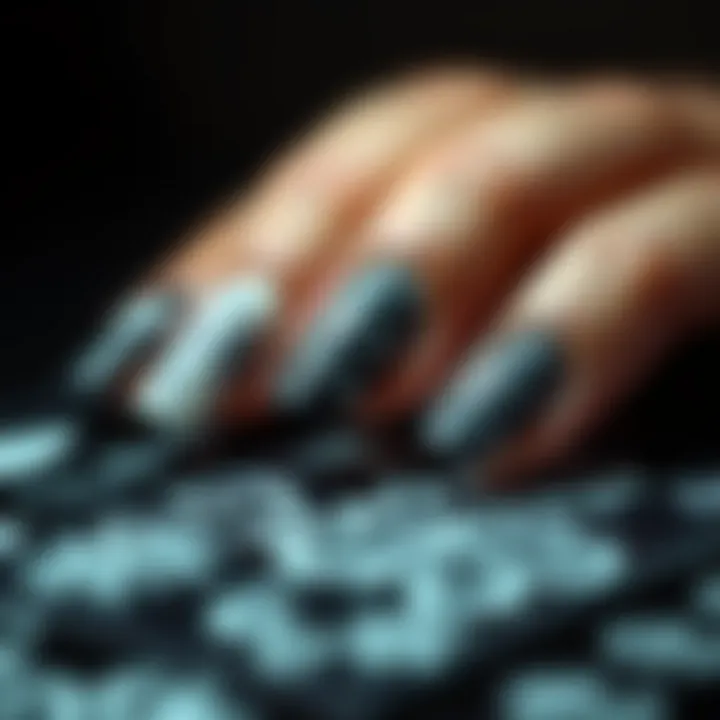
Intro
In the vibrant world of nail artistry, manicure stencils offer a gateway to endless creativity and precision. These clever tools stem from the desire to translate complex designs onto nails with ease and flair. Today, we will explore the diverse types of stencils available, and how they can revolutionize your nail art game.
Nail art is no longer just a splash of color; it has evolved into a sophisticated medium where individuals express their unique styles and personalities. With stencils, even those with unsteady hands can achieve intricate patterns that once seemed daunting. These handy templates allow for a level of detail that can make a simple manicure extraordinary. Whether you're trying to mimic sophisticated lace patterns or cheerful geometrics, stencils can elevate your nail designs to new heights.
Moreover, the versatility of stencils makes them not just useful but essential for both beginners and seasoned nail artists. They provide a framework for experimentation, enabling aspiring artists to step out of their comfort zones without the fear of making irreversible mistakes. Alongside precise application techniques and knowledge about the various materials available, understanding stencils becomes crucial.
Now, let's navigate through the various aspects of manicure stencils, from their types and applications to tackling common challenges. There’s a rich world to discover when it comes to integrating stencils into your nail routines and, ultimately, mastering the art. \n
Types of Manicure Stencils
When delving into the realm of manicure stencils, it’s essential to familiarize yourself with the different types that can be harnessed for various artistic expressions.
- Adhesive Stencils: These are quite popular due to their stickiness and reusability. Just peel off the backing and align the stencil on your nail for a clean outline, making them invaluable for designs requiring accuracy.
- Reusable Stencils: Made from materials like mylar, these stencils can withstand multiple uses. They are often ideal for those who create the same design frequently, combining efficiency with cost-effectiveness.
- Negative Space Stencils: This innovative type works by allowing your nail's natural color or base coat to show through, creating intricate designs that play beautifully with light and color.
Each type serves unique purposes, and mastering them can lead to remarkably varied outcomes.
Techniques for Ideal Results
Achieving the perfect manicure requires more than just choosing the right stencil; it also encompasses refining your technique. Here are some recommendations that could lead to stunning nail designs:
- Preparation is Key: Before applying stencils, ensure nails are clean and prepped. A tidy canvas lends itself to better results, reducing the effects of any smudges.
- Timing Matters: Allow your base coat to dry fully before applying the stencil. Patience pays off, and rushing the process can lead to unsatisfactory results.
- Use the Right Tools: Opt for a good-quality brush or sponge applicator for the polish application. The tool's quality can significantly influence the final look.
"A few moments of diligence can simplify the task and enhance the quality of your nail art design."
By focusing on these techniques, both newcomers and experienced artists can avoid frustration and create standout nail art every time.
Common Challenges
With great creativity, however, comes some common hurdles. Almost every nail artist encounters a few hiccups when using stencils:
- Bleeding or Smudging: One of the most frequent issues is polish bleeding under the stencil, leading to messy designs. To tackle this, ensure that your stencil is securely placed on your nail and use less polish than you think you need.
- Stencil Shift: During application, stencils can sometimes shift position. Taping the edges down can help secure them into place and provide cleaner lines.
- Cleaning Up: It’s almost inevitable that some polish might spill outside of the stencil lines. A fine detailing brush dipped in remover can swiftly help clean up those edges, ensuring a polished final look.
By formulating strategies to overcome these challenges, one's confidence and skills in nail artistry will flourish.
Final Thoughts
As we navigate the extensive options and challenging aspects of manicure stencils, it becomes clear that they offer both a canvas and a tool for creativity. The only limit is your imagination. As you embark on this enlightening journey towards mastering these tools, remember to experiment, practice, and make every design a reflection of your individuality. For further exploration, you might check resources such as Wikipedia or engage with communities on Reddit. Elevate your artistry and let your nails tell your story!
Understanding Manicure Stencils
Manicure stencils have carved a unique niche within the realm of nail artistry, acting as both an aid for precision and a canvas for creativity. The importance of understanding these tools cannot be overstated for enthusiasts and professionals alike. They provide a means to instantly up the ante of any manicure, making elaborate designs accessible to anyone willing to use them.
It's not just about aesthetics; it’s about the ease they offer in achieving consistent patterns. Anyone who has applied nail polish knows that the finer details can become a headache without the right approach. Stencils address this challenge, allowing users to create sharp lines and intricate designs that may otherwise be difficult to achieve freehand. This tool is a game changer, especially for those who might feel their painting skills fall short.
Definition and Functionality
Manicure stencils can be defined as templates used during the nail art process to assist in the application of polish in various patterns and designs. Their functionality primarily hinges on their ability to act as barriers, preventing overlap and ensuring that colors do not bleed into undesired areas. Made from a variety of materials, they can be applied directly onto the nail surface. A typical user simply places the stencil on their nail and paints over it; upon removal, they are left with a clean, defined design. Whether you’re looking to create geometric shapes, floral accents, or playful motifs, stencils allow flexibity while simplifying the process.
Historical Context
A stroll through the history of manicure stencils reveals an evolution reflective of changing beauty standards and innovations in nail care. While the modern stencils we know today likely gained traction in the late 20th century, nail art itself dates back thousands of years. Notably, in ancient Egypt, henna was used for body decoration, including nails. Eventually, as nail polishes evolved, so did the techniques people used to express themselves creatively.
The 1980s saw the introduction of sticker-type stencils, which added dimension to nail designs without requiring advanced skills. As beauty trends shifted rapidly through the 1990s and early 2000s, so did the forms and designs of stencils, leading to today’s high-quality versions made from durable materials like vinyl and plastic. Each leap in technology has opened doors to new possibilities in nail artistry. Thus, understanding the historical context not only sheds light on the present-day stencils but also enriches one’s appreciation for this vital tool in nail art.
Types of Manicure Stencils
The world of manicure stencils is as varied as the designs they help create. Understanding the different types not only enhances the nail art experience but also informs choice based on specific needs. This section examines the vital distinctions between types of stencils, considering their functional benefits and practical implications. Choosing the right type of stencil can greatly impact the overall outcome of your nail art, highlighting the importance of this aspect in manicure application.
Reusable Versus Disposable Stencils
When shopping for stencils, one of the first distinctions to consider is between reusable and disposable options. Reusable stencils are often made of durable materials and can withstand multiple uses, making them ideal for regular nail artists or enthusiasts who love experimenting with different designs.
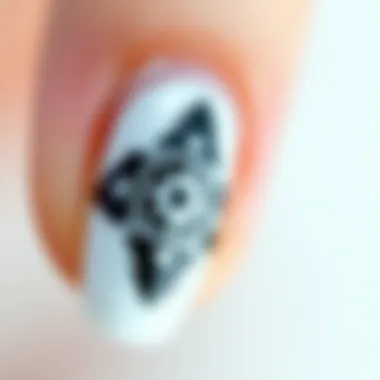
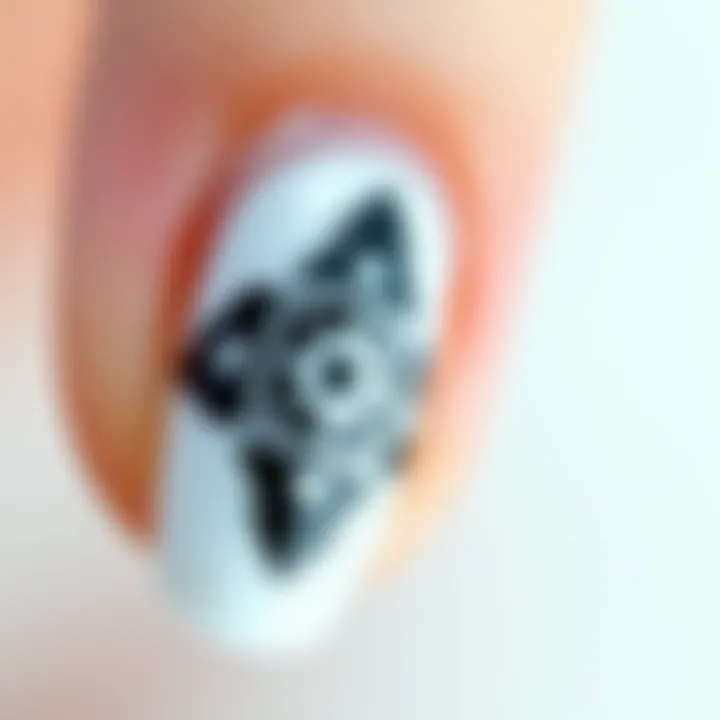
The key characteristic of reusable stencils is their longevity. A good quality plastic or vinyl can last through many nail art sessions, which is beneficial for those who want to minimize waste while maximizing creativity. However, they often require careful cleaning after each use to maintain effectiveness.
On the other hand, disposable stencils are typically designed for single use. They can be more convenient since there’s no fuss about cleaning them, making them appealing for those new to nail art or for special events. While they may be an economical choice in the short term, frequent purchases can add up, raising questions about sustainability as you go through packs of them.
Material Variations
Materials play a significant role in the functionality and effectiveness of nail stencils. The most common materials include plastic, vinyl, and paper, each boasting unique characteristics that cater to different preferences and styles.
Plastic Stencils
Plastic stencils are well-regarded for their durability and ease of handling. Often made from flexible yet sturdy materials, they hold up well during use, making them a popular choice among professionals and hobbyists alike.
The key characteristic of plastic stencils is their ability to curve and conform to the nail's natural shape, ensuring a better application without gaps or misalignment. A unique feature is their washable surface that allows for repeated use after simple cleaning, making them cost-effective over time. However, they might be prone to scratches if not cared for properly.
Vinyl Stencils
Vinyl stencils are often lauded for their adhesive quality and precision. They can stick firmly to the nail's surface, reducing the risk of messy applications.
What makes vinyl stencils particularly advantageous is their thinness which permits the precise transfer of polish, resulting in sharp designs. They are also reusable, but their lifespan is shorter than that of plastic stencils because the adhesive can degrade after multiple uses. This specific aspect may cause some challenges for users seeking longevity with more intricate designs, as they can lose stickiness over time.
Paper Stencils
While they may seem basic, paper stencils can be surprisingly effective, especially when it comes to intricate designs. Their light weight makes them easy to handle, and they’re often more affordable than their plastic or vinyl counterparts.
Key characteristic of paper stencils is their ability to absorb polish quickly, resulting in vivid color application without smudging, if handled correctly. A great option for themed occasions, they can often be customized at home for unique nail art. However, they do not stand up well against moisture and can tear easily, restricting their usage to single, planned applications.
Design Categories
The flexibility in design offered by stencils opens a wealth of creativity. Different design categories fit various styles and themes, whether it's for a simple day out or a grand occasion.
Geometric Patterns
Geometric patterns are trendy and modern, lending a sleek look to manicured nails. They often embody clean lines and can be combined creatively with colors to create a striking visual effect. The key characteristic of geometric stencils is their precision, allowing for sharp shapes and angles which appeal to minimalist designs. However, these designs can be challenging to achieve perfectly without a steady hand.
Floral Designs
Floral stencils are ideal for bringing vibrancy and life to nails. They can include everything from delicate petals to full bouquets. The key attribute of floral designs is their inherent detail and artistic flair, making them a favorite among those who prefer a more feminine touch. The potential downside is that intricate floral patterns may require more skill to apply without smudging, which can be daunting for beginners.
Customizable Options
Customizable stencils provide the freedom to personalize nail designs. This adaptability allows users to create unique patterns that resonate with their personal style or the mood of the moment. Key characteristic is their versatility, which often transforms the mundane into something special. However, creating custom designs can involve more steps and potentially more materials, which might complicate the process for those looking for simplicity.
"The beauty of nail art is that it’s a canvas. With stencils, it’s like having a paintbrush - you can create anything your heart desires."
Understanding these various types of manicure stencils enables enthusiasts and professionals to make informed choices that cater to their creative needs, ensuring each nail art project is a delightful venture.
Benefits of Using Manicure Stencils
Manicure stencils have transformed the world of nail art, offering more than just a quick way to dress up nails. They bring a unique set of benefits that appeal to professionals and DIY enthusiasts alike. Understanding these advantages can help nail artists elevate their work, whether for personal expression or preparing for client appointments. In this section, we will delve into three primary benefits: precision and consistency, time efficiency, and creative freedom.
Precision and Consistency
Nail artistry demands an eye for detail. One of the most celebrated benefits of using manicure stencils is the precision they provide. With stencils, users can expect clean lines and perfectly shaped designs that might be tricky to achieve freehand. For instance, intricate patterns such as chevrons or negative space designs can be executed flawlessly.
When stencils are well-made, they can be positioned on the nail easily, ensuring that the design fits just right. This results in a consistent appearance that can be particularly beneficial for those in the salon industry, where delivering uniformity is crucial. Furthermore, having this kind of reliability allows nail technicians to focus on their client's preferences rather than fussing over uneven designs. Consistency becomes particularly vital for branding in salon environments, where recognizable styles can enhance reputation and customer loyalty.
Time Efficiency
In today’s fast-paced world, time is money. For nail artists, the ability to create stunning designs in a fraction of time can significantly affect productivity and profitability. Manicure stencils simplify the application process, reducing the time spent on nail art.
Imagine working with a client who wants a complex geometric design; with stencils, a design that might take hours to accomplish freehand can be completed in mere minutes. This time-saving aspect benefits both the artist and the client, as it increases throughput for salons while simultaneously ensuring clients walk away with beautiful nails that meet their expectations. Moreover, for those working from home or doing their own nails, this efficiency means more time for other activities or simply enjoying the results of their hard work without the stress.
Creative Freedom
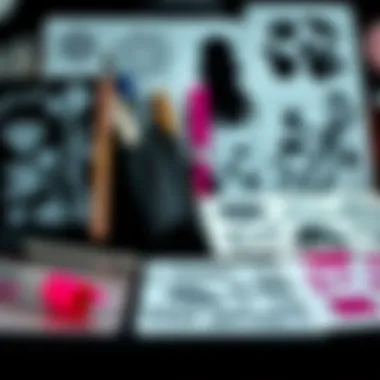

While some may view stencils as restrictive, they actually promote creative freedom. There's truth to the adage that "limitations breed creativity." With a foundational design in place, artists can layer colors and textures to redefine styles, turning simple nail art into a unique signature.
Stencils allow for experimentation without the fear of ruining a design. For example, someone attempting a watercolor technique might find it daunting to do without guidance. Yet, with a stencil, they can confidently explore different colors and applications. This exploration nurtures artistry, encouraging risk-taking with fewer consequences. Additionally, the wide array of stencils available—ranging from floral to holiday themes—opens up endless possibilities, making it easier for users to adapt trends that better align with their personal style or their clients’ preferences.
"Manicure stencils are like the secret weapon for creative expression in nail art."
In summary, the benefits of using manicure stencils are substantial. They not only enhance precision and efficiency but also fuel creativity, allowing artists to push boundaries. As the nail art industry continues to evolve, stencils will likely remain a cornerstone for those looking to marry skill with innovation.
Techniques for Effective Stencil Application
Applying nail stencils correctly can make a world of difference in achieving the desired artistic effect. Mastering the techniques involved not only enhances the aesthetic appeal but also boosts confidence in one’s nail art abilities. Proper application, from nail prep to polish choice and actual stencil engagement, can lead to stunning and professional-looking results. Without a methodical approach, even the most beautiful stencils can produce frustratingly imperfect results.
Preparation of Nails
Before any design can take shape, the initial canvas—the nails—should be in prime condition. This step is all about creating a smooth and even surface, which is foundational for any successful manicure. Start with gently pushing back cuticles and trimming any overgrowth to avoid unwanted polish smudging. Following that, a good scrubbing with soap and water or a nail cleanser removes dirt and oils, ensuring that the polish adheres well.
Once dried, it’s wise to apply a base coat. This serves dual purposes: it prevents nails from staining and allows for a smoother application of color. Additionally, a well-prepped nail surface can significantly improve the longevity of the nail art that follows, making this step not just optional, but essential.
Choosing the Right Polish
Not all polishes are created equal when it comes to stencil application. Opting for a thicker polish—sometimes referred to as "gel" or "heavy-duty"—can yield better results as it holds its shape well while also ensuring the design doesn't bleed. But do not overlook the drying time; polishes that dry too quickly can cause complications when removing stencils.
Shiny or matte finish? It all comes down to preference and design goals. For intricate designs, a high-gloss polish can enhance the clean lines, while a matte finish might suit a more subdued look. Keeping in mind the contrast between the polish color and stencil design also plays a huge role. A dark stencil over a light polish—or vice versa—ensures that the aesthetic pops.
Application Process
Positioning the Stencil
The placement of the stencil is crucial for attaining a precise design. Aligning the stencil correctly ensures that the image is positioned exactly where intended on the nail. Many stencils come with adhesive backing, which helps in keeping them steady. This is a definite plus, as a well-placed stencil can prevent movement during the polish application, reducing the chances of smudging. It’s worth noting that misalignment, even by a hair's breadth, can ruin an otherwise perfect design. Moreover, a solid grip when applying the stencil helps in achieving a crisp design with minimal interference from the surrounding areas.
Polish Application Techniques
When it comes to applying polish over the stencil, less can indeed be more. A small amount of polish on the brush, applied gently and evenly, is key to avoid overflow. Dab the polish on rather than swiping, ensuring the design fills the stencil openings without creating a mess. Compression is beneficial here; this can mean applying a bit more force while dabbing to really push the polish into those intricate areas. Testing this on a scrap piece can help nail down technique before hitting the natural nails.
Removing the Stencil
Patience pays off when it comes time to remove the stencil. Pulling it off too early can lead to smudging, while waiting too long may dry the polish onto the stencil, complicating removal. A gentle lift from one corner, allowing for the polish to set for a minute or two, usually provides the best results. This technique also allows any last-minute adjustments to be made before the polish sets fully. Cleaning the stencil between uses or designs maintains its integrity and ensures that no residual polish tarnishes future applications.
A great stencil application requires going slow and methodical. It’s tempting to rush through the process, but taking the time ensures a design that really shines.
Each stage of applying stencils demands attention to detail and care. Combining these techniques leads to beautiful and professional-quality nail designs, enhancing the overall manicure experience. Furthermore, thorough preparation and mindful execution turn an ordinary nail session into an extraordinary journey of creativity.
Common Challenges and Solutions
Manicure stencils can be a game changer for nail enthusiasts, elevating basic manicures to stunning displays of artistry. However, just like any tool, they come with their own set of challenges. Understanding these common hurdles and finding effective solutions is crucial for achieving the desired results. Here, we take a in-depth look at several of these challenges to empower nail artists and hobbyists alike.
Smudging and Smearing
One of the most frequent annoyances faced during the use of stencils is smudging or smearing of nail polish. This can happen for a number of reasons. If the polish is still wet when you lift the stencil, it can easily lead to a messy outcome. To combat this, it's wise to prioritize patience. Allow your base coat to dry thoroughly before applying the stencil. Additionally, consider using quick-dry formulas. Many brands offer polishes designed to dry faster than standard formulas, which can reduce the risk of smudging. Alternatively, you might use a fast-drying topcoat on the stencil once it’s fully applied.
- Tips to Avoid Smudging:
- Let the base coat dry completely.
- Opt for fast-drying nail polishes.
- Apply a clear top coat over the design before removal.
Uneven Application
Achieving a uniform finish with stencils can sometimes feel like trying to catch smoke with your bare hands. Uneven application often results from improper positioning or uneven pressure while applying polish. To ensure an even finish, start by positioning the stencil firmly against the nail, making sure it's not only aligned but also pressed down securely with your fingers.
A common technique is to use a sponge to dab polish onto the stencil rather than brushing it on. This can lead to less pooling of the polish and a more consistent application. If you find yourself frequently battling uneven layers, practicing your technique on practice nails can be beneficial. It’s completely fair to make mistakes; that’s often how we learn.
- Strategies for Uniform Application:
- Position the stencil carefully and firmly.
- Use a tapping motion with a sponge for even coverage.
- Experiment on practice nails for confidence and skill.
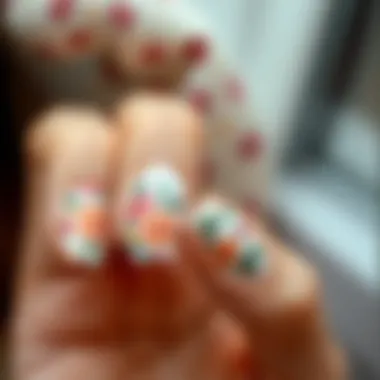
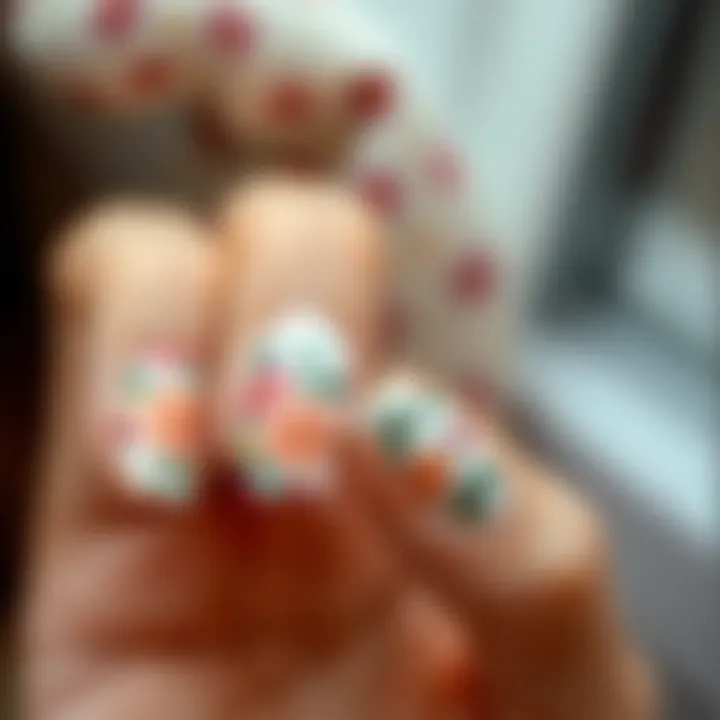
Stencil Adhesive Issues
Often overlooked, the adhesive quality of a stencil can make all the difference between a successful nail design and a total disaster. If a stencil isn’t sticking to the nail properly, it can allow polish to seep underneath, resulting in a blurred design. One common cause of poor adhesion is excess moisture on the nail surface.
Ensure that your nails are clean and dry before applying stencils. If the problem persists, consider switching to stencils with stronger, skin-friendly adhesives. There are also adhesive sprays available specifically designed for nail art that can help keep stencils in place during application. Nevertheless, tread lightly with these products as over-application can create a sticky mess.
- Best Practices for Adhesive Issues:
- Clean nails thoroughly before application.
- Opt for higher-quality stencils with good adhesive properties.
- Consider using specialized adhesive sprays if necessary.
Addressing these challenges effectively can significantly enhance your nail art experience. By implementing these solutions, nail enthusiasts can enjoy a smoother application process and achieve beautiful results.
Nail Art Trends Featuring Stencils
Manicure stencils have made quite a splash in the world of nail art, forging a bond between creativity and convenience. The trends that have emerged around these handy tools highlight their significance in transforming plain nails into canvases of expression. Using stencils broadens the scope for artistic ventures, allowing for an array of designs that cater to various styles, moods, and occasions. Not just a passing fad, the integration of stencils into nail artistry reflects a fusion of traditional techniques with modern innovation.
Seasonal Designs
Winter Themes
Winter designs evoke a cozy, festive atmosphere that resonates with the chill in the air. They often incorporate snowflakes, icicles, and warm sweaters, making them visually appealing. The key characteristic of winter themes is their emphasis on delicate, intricate patterns that capture the essence of the season. This makes them am exceptionally popular choice among those looking to add a seasonal touch to their manicures.
The unique feature here is the variety of color palettes available. Soft blues, whites, and silvers mimic the snow and ice, while warm tones can be added to reflect the holiday spirit. One advantage of winter-themed stencils is that they can serve dual purposes: practical for personal use and great as a winter selling point for nail salons. However, their detailed designs might not be as beginner-friendly; some may find them challenging to apply evenly, leading to frustration.
Summer Patterns
Conversely, summer patterns bring forth a completely different energy. Vibrant colors, tropical motifs, and fresh elements are the hallmark of summer nail art. Think of palm trees, beach balls, or fruity designs. This seasonal trend allows for an explosion of creativity, encouraging users to go bold and bright.
The key characteristic of summer designs is their playful nature, making them a fun choice for casual outings or beach trips. Bright neons and pastel shades triumph in this season, providing a joyful escape from everyday monotony. One unique advantage of summer patterns is that they can adapt well to a variety of designs—whether one opts for simple waves or complex floral arrangements, there's versatility galore. However, with such vivid colors, achieving the right finish can be tricky, as some may require multiple layers to achieve the desired depth.
Occasion-Specific Styles
Holiday Celebrations
The festive seasons are a treasure trove of inspiration, with holiday celebrations prompting a flurry of creativity in nail design. Stencils featuring Santa, ornaments, and even candy canes are favored for their ability to deliver festive cheer right at your fingertips. This playful and celebratory aspect makes holiday-themed stencils a glossy crown jewel in the nail art toolkit.
The unique feature of holiday celebrations stencils is their engagement in a cultural narrative; they reflect social traditions and themes, providing a means for individuals to connect with broader festivities. Their primary advantage lies in their instant visibility, causing designs to stand out during family gatherings or firework displays. Conversely, it often leads to crowded designs that some folks might find overwhelming.
Bridal Designs
In contrast, bridal designs encapsulate a softer, more sophisticated elegance that speaks to romance and poise. Stencils that feature lace patterns, delicate florals, or subtle embellishments are preferred for their understated beauty. These designs are particularly beneficial for brides wanting to achieve intricate nail art without spending a fortune at salons.
The unique aspect of bridal designs is their adaptability, as they can easily blend with the wedding's color scheme and theme. These stencils stand out for their ability to provide a touch of elegance on what is often a day filled with opulence. However, the challenge lies in maintaining the design through various activities of the day, from the ceremony to the reception. Brides often have to be cautious and strategize application to avoid smudging while mingling with guests.
As we engage with these trends, it becomes clear that manicure stencils are more than mere tools; they are avenues for personal expression, creativity, and connection to the seasons and significant life events. The marriage of artistry with functionality offers a unique platform for both nail enthusiasts and professionals alike.
The Future of Manicure Stencils
As the nail art landscape continually evolves, the significance of exploring the future of manicure stencils cannot be overstated. This section will delve into how upcoming innovations and technology integration hold the potential to revolutionize the practice. Such exploration is not only relevant for creative aspirations but also for practicality within the beauty industry as a whole, influencing how professionals and enthusiasts alike approach nail designs.
Innovations in Materials and Design
In the ever-changing realm of manicure stencils, material innovations are emerging. Gone are the days when stencils were merely made from basic plastic or paper. Today's stencils harness advanced materials, such as eco-friendly biodegradable options and flexible yet durable vinyl, allowing for more intricate designs without compromising durability. These innovations not only enhance the aesthetic appeal of the stencils but also cater to a more environmentally conscious market.
Improved adhesive properties in new stencil designs are facilitating better application and easier removal without damaging the polish underneath. Lightweight materials designed with cutting-edge technology are eschewing the friction and tearing often associated with traditional stencils, paving the way for a smoother application process. These advancements elevate the quality of nail art significantly, making complex styles easier to achieve.
Integration with Technology
Digital Stencil Machines
Digital stencil machines represent a groundbreaking leap in the world of manicure tools. These machines allow users to create highly detailed designs with precision, transforming how nail art is conceptualized and executed. The key characteristic of digital stencil machines is their ability to customize intricate patterns that can be directly printed or cut out, allowing for personalization like never before.
One major advantage of digital stencil machines is efficiency. Nail artists can produce a variety of designs in a fraction of the time it would take to do by hand, thus optimizing their workflow. However, such machines do require an upfront investment which may not be feasible for all, but their potential return in increased productivity and artistic flexibility can be substantial.
Custom Design Applications
Custom design applications open up a new frontier for manicure stencils. This technology enables users to create their designs digitally and have them transformed into stencils for nail art, with ease. The primary appeal of custom design applications lies in their versatility; users can bring any idea to life, breaking away from standardized patterns.
Key benefits of these applications include the sheer breadth of creativity they unleash. From personalized monograms to unique motifs, the options seem endless. However, the learning curve can be steep. While today's apps are becoming user-friendly, proficient design skills are essential in crafting appealing and manageable stencil designs. This might deter some hobbyists but will likely attract professionals seeking to differentiate their services.
Overall, the future of manicure stencils is poised to be bright. With constant advancements in materials and technology, the nail artistry field is not just about keeping pace, but about leaping ahead into new aesthetics and efficiencies. As these innovations unfold, they promise to catalyze a deeper creativity in nail art, making the world of manicures even more exciting.















